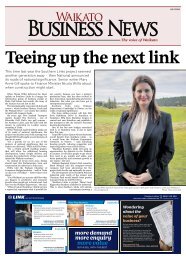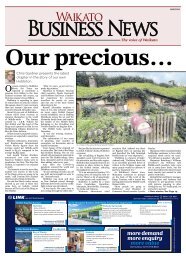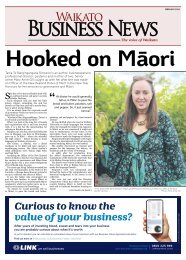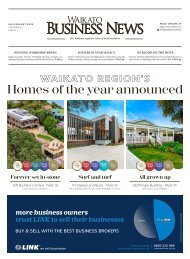Waikato Business News | January 12, 2024
Create successful ePaper yourself
Turn your PDF publications into a flip-book with our unique Google optimized e-Paper software.
8 WAIKATO BUSINESS NEWS<br />
JANUARY <strong>2024</strong><br />
ADVERTORIAL<br />
Commercial Leases ?<br />
– Agreement to Lease or<br />
Deed of Lease<br />
University opens<br />
new business hub<br />
Commercial property lease<br />
transactions consist of<br />
formalising the relationship<br />
between Landlords and<br />
Tenants. Two key documents in this<br />
context are the Agreement to Lease<br />
and the Deed of Lease, with each<br />
serving a specific purpose.<br />
Agreement to Lease:<br />
The Agreement to Lease is typically<br />
the first document in the commercial<br />
leasing process, setting out the<br />
broad commercial terms of the<br />
lease – things like the length of the<br />
lease, commencement date, how<br />
much rental will be, the rent review<br />
provisions, along with any required<br />
works or conditions to be met. It is<br />
a legally binding document, albeit<br />
that it may be conditional for a period<br />
of time, providing an option to not<br />
proceed if the conditions are not<br />
met. This document is particularly<br />
useful when parties want to quickly<br />
establish the basic terms of the lease<br />
without delving into the extensive<br />
details typically found in a full lease<br />
agreement.<br />
There are also occasions where<br />
parties may instead agree to an<br />
alternative Heads of Terms type<br />
document, that highlight the general<br />
terms, but in many instances are nonbinding.<br />
Several Key Elements of an Agreement<br />
to Lease:<br />
Basic Terms: The Agreement to Lease<br />
covers fundamental aspects such as<br />
the names of the parties, the property<br />
details, the term of the lease, and rental<br />
amounts.<br />
Conditions: It may include<br />
conditions that need to be met or<br />
satisfied before the lease becomes<br />
binding. These conditions might involve<br />
obtaining necessary consents, permits,<br />
or completing certain works on the<br />
property. For example, a lease may not<br />
start until the Landlord has finished<br />
building the premises. In this case the<br />
Agreement to Lease will only state an<br />
estimated commencement date. The<br />
Deed of Lease will then record when<br />
the building was finished, and when the<br />
lease started. It is always good to know<br />
exactly when your lease commenced,<br />
so you know exactly when it will end.<br />
Negotiation Platform: The<br />
Agreement to Lease serves as a<br />
platform for negotiations through<br />
an offer and counter offering, where<br />
necessary. Once the parties agree on<br />
the essential terms and it becomes<br />
unconditional, they can proceed to<br />
finalize the more comprehensive Deed<br />
of Lease in due course.<br />
Deed of Lease:<br />
Once the parties have a fully<br />
executed Agreement to Lease,<br />
and all conditions have been<br />
satisfied, the next step is for<br />
the Tenant and the Landlord<br />
to enter into a formal<br />
Deed of Lease, which<br />
is usually prepared by<br />
the Landlord’s lawyer.<br />
The most common<br />
type being the ADLS<br />
(Auckland District Law Society) form,<br />
though some Tenants and Landlords<br />
may have their own bespoke versions<br />
or standard modifications. The latest<br />
version being the ADLS 6th Edition<br />
20<strong>12</strong> (5) form, with each party normally<br />
paying their own legal costs associated<br />
with the negotiation and preparation of<br />
both the Agreement to Lease and Deed<br />
of Lease documents.<br />
Other Key Components of<br />
a Deed of Lease:<br />
Rights, Responsibilities and<br />
Obligations:<br />
Enumerates the rights and<br />
responsibilities of both the Landlord<br />
and the Tenant, including maintenance<br />
obligations, use of the property,<br />
reinstatement at the end of the lease<br />
and compliance with laws.<br />
Termination and Renewal:<br />
Provides details on circumstances<br />
under which the lease can be<br />
terminated, as well as any provisions<br />
for renewal or extension.<br />
Dispute Resolution:<br />
Includes provisions for resolving<br />
disputes that may arise during the<br />
lease term.<br />
Alterations and Improvements:<br />
Governs any alterations or<br />
improvements the Tenant may wish to<br />
make to the property.<br />
In summary, the Agreement to<br />
Lease and the Deed of Lease play<br />
distinct roles in the commercial<br />
leasing process. The former initiates<br />
negotiations and establishes initial<br />
terms, while the latter formalizes the<br />
agreement, providing a comprehensive<br />
legal framework for the Landlord-<br />
Tenant relationship. Both documents<br />
are integral to ensuring a clear and<br />
mutually beneficial commercial<br />
property transaction and relationship.<br />
As outlined above, when you sign an<br />
Agreement to Lease you are bound by<br />
the terms of a Deed of Lease as well, so<br />
it makes sense to know exactly what a<br />
Deed of Lease contains.<br />
Having a final Deed of Lease in<br />
place is important if you ever wished<br />
to assign the lease to another party.<br />
Clause 6.1 of a standard ADLS<br />
Agreement to Lease states that<br />
the Agreement to Lease cannot be<br />
assigned.<br />
Under REAA 2008 we (real estate<br />
agents) are required to recommend<br />
to all parties, before entering into a<br />
lease arrangement, that they should<br />
seek legal and other professional<br />
advice prior to signing any lease<br />
documentation. Engaging an<br />
experienced commercial lawyer<br />
for advice in these circumstances<br />
is very important, particularly for<br />
those who are new to leasing.<br />
Ready and waiting – inside the university’s new hub.<br />
A new business precinct and co-working<br />
space at the Hamilton campus is designed<br />
to strengthen ties between the business<br />
community and the University.<br />
Hiko hub will provide businesses with<br />
the flexibility of a co-working space and<br />
the benefits of the campus’ unique grounds<br />
and amenities. <strong>Business</strong>es that join the<br />
hub will also have opportunities to connect<br />
with students through work experience<br />
opportunities, including work-integrated<br />
learning.<br />
<strong>Waikato</strong> University chief operating officer<br />
Jim Mercer, said the project was a positive<br />
step for the university and the <strong>Waikato</strong><br />
business community.<br />
“This concept has been brewing for<br />
several years, driven by our commitment to<br />
work more closely with local industry and<br />
Straight teeth – and good luck<br />
CONTINUED FROM PAGE 5<br />
When she became practice manager for<br />
an ear, nose and throat specialist, she was<br />
sure it was the best job of her life. “I learned<br />
how to run people and be a boss, and having<br />
to wear smocks meant I didn’t need a full<br />
working wardrobe.”<br />
She worked through lunch so she could<br />
pick the kids up after school and waitressed<br />
three nights a week.<br />
The next seismic event occurred when she<br />
met established businessman Bill Foreman<br />
and his then wife, Mary Pat. Bill was<br />
running Trigon, based out of Hamilton’s<br />
Foreman Rd. A nagging hearing problem<br />
brought him into the practice and the family<br />
soon bonded with Diane over their shared<br />
experience as adoptive parents. Bill regaled<br />
Diane telling her story to a packed U3A meeting.<br />
<br />
Photo: Bruce Hancock<br />
make smarter use of our space. Hiko hub<br />
addresses a genuine demand from small<br />
businesses in the region seeking a vibrant<br />
and contemporary workplace while being<br />
part of a larger ecosystem.”<br />
Tech company Resolution8 has signed<br />
on with the hub and will be moving into the<br />
space early this year. Director Peter Gilbert<br />
said the close ties to an organisation known<br />
for its strong tech credentials was a drawcard.<br />
“From establishing New Zealand’s first<br />
internet connection in 1989 to leading the<br />
way now with their Artificial Intelligence<br />
Institute, the University has long led the<br />
way in tech. Resolution8 prides itself<br />
on innovation, so it feels like a natural<br />
alignment,” he said.<br />
The hub gets its name from the Māori<br />
word for lightning or “to ignite”.<br />
her with business chat and gave her copies<br />
of National <strong>Business</strong> Review to read.<br />
Time passed and Diane, seeking more<br />
in life, left the practice and became a real<br />
estate agent. Later, when she dropped into<br />
her former boss to get property papers<br />
signed, she stumbled across Bill. Mary Pat<br />
had died a week earlier and conversation<br />
was awkward, but a month later, Bill invited<br />
Diane for tea. She was sure he would offer<br />
her a job as a secretary, or perhaps as nanny<br />
for his children. Several similar meetings<br />
followed until Diane asked when he was<br />
going to offer her the job…instead, he asked<br />
her to marry him.<br />
Mary Pat, concerned at leaving young<br />
children for Bill to raise alone, had<br />
prophetically reminded him of the sharp<br />
young woman at the ENT practice. Bill<br />
conducted his own appraisal, something<br />
Diane later learned was a key component to<br />
his business success, and the two married<br />
in 1988.<br />
She was instantly propelled into a different<br />
world. “It was the best decision I ever made<br />
… he changed my life,” Diane said. “First, I<br />
learned to be a corporate wife. We travelled<br />
the world and I’d sit in boardrooms and<br />
meet with his directors. Then the third<br />
big thing happened. Bill had a stroke and<br />
asked me to go onto the board at Trigon as<br />
a director… he wanted me to take it over.”<br />
Despite her terror, she deftly navigated the<br />
misogynism and mastered the challenges.<br />
When they sold Trigon in 1995, they pursued<br />
numerous other business interests that took<br />
them across the globe until Bill’s death in<br />
2017 marked the end of an era.<br />
“I learned so much from him,” she said.<br />
“He taught me that people are the biggest<br />
asset to any business… through him I<br />
learned how to select and hold on to the<br />
best people.”<br />
Diane continued to blaze her own path<br />
as a highly respected businesswoman. She<br />
reckons she was lucky to learn from the best,<br />
and in 2015 published her best-selling book<br />
on entrepreneurship, In the Arena.

















